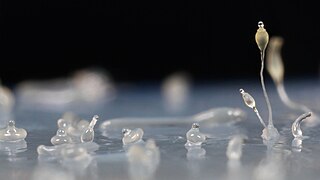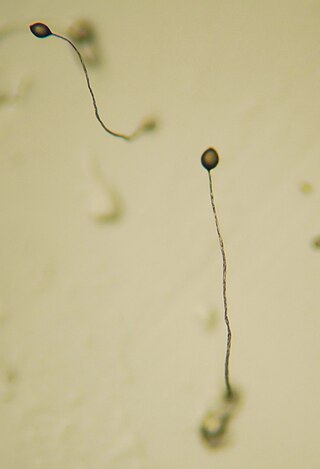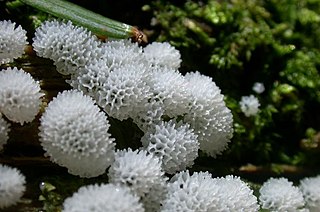
A flagellate is a cell or organism with one or more whip-like appendages called flagella. The word flagellate also describes a particular construction characteristic of many prokaryotes and eukaryotes and their means of motion. The term presently does not imply any specific relationship or classification of the organisms that possess flagella. However, the term "flagellate" is included in other terms which are more formally characterized.

The Percolozoa are a group of colourless, non-photosynthetic Excavata, including many that can transform between amoeboid, flagellate, and cyst stages.

Nucleariida is a group of amoebae with filose pseudopods, known mostly from soils and freshwater. They are distinguished from the superficially similar vampyrellids mainly by having mitochondria with discoid cristae, in the absence of superficial granules, and in the way they consume food.

Slime mold or slime mould is an informal name given to a polyphyletic assemblage of unrelated eukaryotic organisms in the Stramenopiles, Rhizaria, Discoba, Amoebozoa and Holomycota clades. Most are microscopic; those in the Myxogastria form larger plasmodial slime molds visible to the naked eye. The slime mold life cycle includes a free-living single-celled stage and the formation of spores. Spores are often produced in macroscopic multicellular or multinucleate fruiting bodies that may be formed through aggregation or fusion; aggregation is driven by chemical signals called acrasins. Slime molds contribute to the decomposition of dead vegetation; some are parasitic.

The dictyostelids or cellular slime molds are a group of slime molds or social amoebae.

Dictyostelium is a genus of single- and multi-celled eukaryotic, phagotrophic bacterivores. Though they are Protista and in no way fungal, they traditionally are known as "slime molds". They are present in most terrestrial ecosystems as a normal and often abundant component of the soil microflora, and play an important role in the maintenance of balanced bacterial populations in soils.

Amoebozoa is a major taxonomic group containing about 2,400 described species of amoeboid protists, often possessing blunt, fingerlike, lobose pseudopods and tubular mitochondrial cristae. In traditional classification schemes, Amoebozoa is usually ranked as a phylum within either the kingdom Protista or the kingdom Protozoa. In the classification favored by the International Society of Protistologists, it is retained as an unranked "supergroup" within Eukaryota. Molecular genetic analysis supports Amoebozoa as a monophyletic clade. Modern studies of eukaryotic phylogenetic trees identify it as the sister group to Opisthokonta, another major clade which contains both fungi and animals as well as several other clades comprising some 300 species of unicellular eukaryotes. Amoebozoa and Opisthokonta are sometimes grouped together in a high-level taxon, variously named Unikonta, Amorphea or Opimoda.

The opisthokonts are a broad group of eukaryotes, including both the animal and fungus kingdoms. The opisthokonts, previously called the "Fungi/Metazoa group", are generally recognized as a clade. Opisthokonts together with Apusomonadida and Breviata comprise the larger clade Obazoa.

Cristidiscoidea or Nucleariae is a proposed basal holomycota clade in which Fonticula and Nucleariida emerged, as sister of the fungi. Since it is close to the divergence between the main lineages of fungi and animals, the study of Cristidiscoidea can provide crucial information on the divergent lifestyles of these groups and the evolution of opisthokonts and slime mold multicellularity. The holomycota tree is following Tedersoo et al.

The family Acrasidae is a family of slime molds which belongs to the excavate group Percolozoa. The name element acrasio- comes from the Greek akrasia, meaning "acting against one's judgement". This group consists of cellular slime molds.

Dictyostelium discoideum is a species of soil-dwelling amoeba belonging to the phylum Amoebozoa, infraphylum Mycetozoa. Commonly referred to as slime mold, D. discoideum is a eukaryote that transitions from a collection of unicellular amoebae into a multicellular slug and then into a fruiting body within its lifetime. Its unique asexual life cycle consists of four stages: vegetative, aggregation, migration, and culmination. The life cycle of D. discoideum is relatively short, which allows for timely viewing of all stages. The cells involved in the life cycle undergo movement, chemical signaling, and development, which are applicable to human cancer research. The simplicity of its life cycle makes D. discoideum a valuable model organism to study genetic, cellular, and biochemical processes in other organisms.

Amoeba is a genus of single-celled amoeboids in the family Amoebidae. The type species of the genus is Amoeba proteus, a common freshwater organism, widely studied in classrooms and laboratories.

Protosteliomycetes/Protosteliales (ICBN) or Protostelea/Protostelia/Protosteliida (ICZN) is a grouping of slime molds from the phylum Mycetozoa. The name can vary depending upon the taxon used. Other names include Protostelea, Protostelia, and Protostelida. When not implying a specific level of classification, the term protostelid or protosteloid amoeba is sometimes used.

Trichiales is an order of slime moulds in the phylum Amoebozoa. Trichiales is one of five orders in the group Myxomycetes, or the true plasmodial slime molds. It is also currently categorized under the superorder Lucisporidia with its sister group, Liceales. The order was first described by Thomas MacBride in 1922, and has retained the same name and status as a defined order in present phylogeny. In the plasmodium form, members of Trichiales lack a columella but have a well-developed capillitium for spore dispersal. The shape and details of the capillitium are used to define families within the order. Spores are brightly coloured, ranging from clear, white and yellow to pink and red-brown tones. The order currently has 4 families, 14 genera and 174 species. Recent molecular research has shown that while Trichiales probably represents a true taxonomic group, its sister group Liceales is likely paraphyletic, and it has been suggested that several genera from the Liceales should be reclassified under Trichiales instead.

Holomycota or Nucletmycea are a basal Opisthokont clade as sister of the Holozoa. It consists of the Cristidiscoidea and the kingdom Fungi. The position of nucleariids, unicellular free-living phagotrophic amoebae, as the earliest lineage of Holomycota suggests that animals and fungi independently acquired complex multicellularity from a common unicellular ancestor and that the osmotrophic lifestyle was originated later in the divergence of this eukaryotic lineage. Opisthosporidians is a recently proposed taxonomic group that includes aphelids, Microsporidia and Cryptomycota, three groups of endoparasites.
A sorocarp is the fruiting body characteristic of certain cellular slime moulds. Each sorocarp consists of both a sorophore (stalk) and a sorus. Sorocarps release spores.
Polysphondylium pallidum is a species of cellular slime mould, a member of the phylum Mycetozoa.

An amoeba, often called an amoeboid, is a type of cell or unicellular organism with the ability to alter its shape, primarily by extending and retracting pseudopods. Amoebae do not form a single taxonomic group; instead, they are found in every major lineage of eukaryotic organisms. Amoeboid cells occur not only among the protozoa, but also in fungi, algae, and animals.

Parvularia atlantis is a filopodiated amoeba which was isolated from a lake in Atlanta and deposited in the American Type Culture Collection (ATCC) under the name Nuclearia sp. ATCC 50694 on 1997 by TK Sawyer. It was classified under the genus Nuclearia and morphologically resembles to Nuclearia species, although it is smaller. Later it was determined that it phylogenetically belongs to a new nucleariid lineage., distantly related to Nuclearia and Fonticula genera – the other two previously described nucleriid genera.

Hemitrichia is a genus of slime molds, of the family Trichiidae, found within the order Trichiida. It was first described by Josef Rostafinski in 1873 and remains a well-defined genus of the slime molds. Hemitrichia species exhibit either plasmodiocarp or sporangium fruiting bodies, both of which are well-known and recognizable slime molds seen on multiple continents. The genus includes Hemtrichia serpula, known as the pretzel slime mold, an iconic and widespread species that has been used to examine speciation in slime molds.















